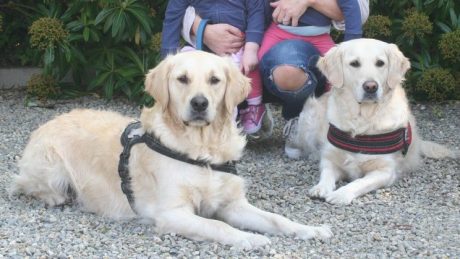
Rabbits are increasingly popular pets in Ireland. They are intelligent, friendly characters that make a good alternative to a dog or cat as the main family pet. Holly has a lifestyle that is typical of a modern rabbit. She lives in a hutch which she shares with a guinea pig called Zak, but she is allowed out to free range around the garden during the daytime. She loves her freedom, and enjoys running and leaping across the lawn. There are cats in the neighbourhood, but they don’t bother Holly at all. In fact, she would be more likely to chase the cats than the other way around.
Holly is fed a standard type of rabbit diet. She has a pet shop mix of flakes and pellets, and this is supplemented by good quality hay, as well as any grazing that she does when she is out in the garden on her own.
Tara had noticed that Holly had changed in appearance and behaviour during the past month. In particular, a large swelling had developed on the underside of her neck, beneath her chin. She had started to pull the hair off this area, and had been pushing it into her sleeping area at night time, so there was now a fluffy, cosy-looking nest for herself and Zak to bed down in. Tara was worried that there could be something wrong with Holly and so she brought her to see me.
I gave Holly a thorough examination, and she seemed to be a particularly healthy rabbit. Her coat was in good condition, her eyes were bright and gleaming, and she was very alert. The swelling under her chin did look peculiar, but I explained to Tara that this is a normal feature of some rabbits as they mature. It is a fold of skin, known as the dewlap, and it can act as a fat store in rabbits that are beginning to put on too much weight. This was exactly what was happening with Holly. It was very likely that she was enjoying the spring burst of plant growth in the garden, eating more young leafy plants than she needed. Holly was showing the first signs of early obesity.
There are three reasons why rabbits are prone to putting on weight. Firstly, they are often descended from breeds of rabbits that were kept for rabbit meat production. As a consequence, they are very efficient at converting excess food into fat stores.
Secondly, pet rabbits do not have to do very much. They can loll around the garden, taking it easy, under no pressure. In comparison, wild rabbits have to spend most of their waking hours searching for food and avoiding predators. They are on the go during all the hours of daylight, burning up energy all the time.
Thirdly, pet rabbits have a plentiful supply of food. Most rabbits are allowed to eat as much as they want, and some rabbit food (such as the pet food grain-based mix) is exceptionally high in calories. This may be fine in the winter, when extra energy is needed to keep warm, and grazing in the garden is scarce. But at other times of the year, it is common for pet rabbits to take in too many calories, resulting in obesity. Holly would not yet be classified as “obese”, but her expanding dewlap was a warning sign that if her diet was not modified, she could soon turn into a “fat bunny”.
For rabbits, as for other animals (and humans), obesity is not good for the health. Apart from the usual risks, such as worsening of problems like heart disease and arthritis, there is a particular problem that is unique to rabbits.
Fat rabbits are unable to turn around far enough to re-ingest their faecal pellets. (This is a strange but necessary part of rabbit biology). As a result, obese rabbits tend to end up with dirty rear ends. This is unpleasant in itself, but it can be dangerous as we head into the warmer weather of summer. Flies are attracted to the dirty areas beneath the rabbit’s tail, and they lay eggs which later hatch into maggots. This results in ‘Fly strike’, one of the most unpleasant and dangerous conditions to afflict pet rabbits.
It was fortunate that Tara had spotted Holly’s weight gain at such an early stage. There is no need for any radical low calorie diets or exercise programmes (and yes, these do exist for rabbits, just as for other pets). Instead, I advised that Tara should dramatically reduce the pet shop mix that she was feeding to Holly. If she reduces the amount of flakes and pellets by around 50%, this should be enough to bring Holly back to a normal weight.
Tara was relieved to hear that Holly’s large dewlap was nothing to worry about, but what about her strange fur-plucking behaviour? What was that about?
The answer is simple: spring is in the air, and Holly’s hormones are surging. In the wild, she would be about to produce her first crop of baby bunnies. The fur-plucking and nest-making behaviour are a natural response to the time of year and are nothing at all to worry about. If Holly was spayed (“neutered”), then the behaviour would settle down, and in fact, for other health reasons, this would be a very good idea. Perhaps a subject for another column….
Tips
- Pet rabbits are as prone to obesity as any other pet
- Often a simple reduction in the dry mix is all that is needed to lose weight
- The sooner the problem is identified, the easier it is to solve




Comments are closed.
Please note that I am unable to answer veterinary questions in comments. If you have questions or concerns about your pet's health it is always better to contact your vet.